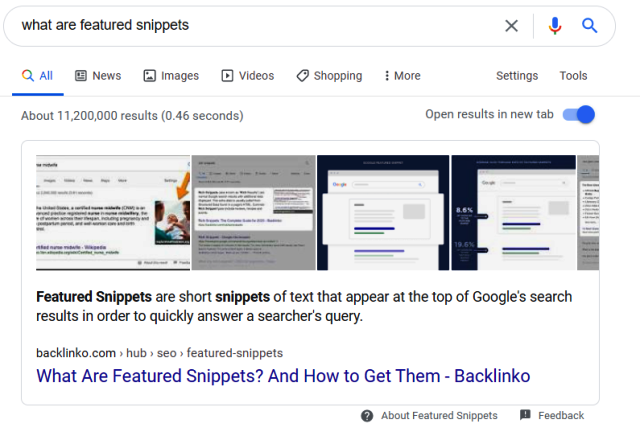Google’s featured snippets at the top of many search results increase website traffic – a lot. Placed in an attention-grabbing box, featured snippets are located in what SEO pros call “position zero,” the highest possible position on page one of search results. A traffic bonanza awaits any website that has its content in a featured snippet. HubSpot reports that featured snippets more than doubled the click-through rate over the next top position. Importantly, Google is adding more content to the snippets, SEO experts say.
“Getting a featured snippet puts you at the front of the pack,” writes Inna Yatsyna, a brand and community developing specialist at Serpstat. “With attention spans going down every second, this is conversion gold.”
The obvious question is: “How do I get my website content into a featured snippet?”
Types of Featured Snippets
First some background on featured snippets.
Featured snippets include:
- Information quoted from a third-party website
- A link to the page
- The page title
- The URL of the page
The format of regular listings is reversed, showing the descriptive snippet first. The quoted content in featured snippets can be a paragraph of text (the most common), a list or set of steps, or a table.
They’re intended to immediately answer the user’s question, which is why they’re also sometimes called “answer boxes.” However, they should not be confused with answers to common questions that Google places in boxes at the top of search results.
Getting Featured in Featured Snippets
Getting featured in featured snippets calls for top-notch SEO and content creation skills.
Yatsyna offers these recommendations:
Include your targeted keyword phrase for a question in an H2 or H3 heading. Focus on a keyword phrase with a decent amount of search traffic to make your effort worthwhile.
Be concise and specific in your answers to your questions.
Make sure your questions are researched and relevant to your keyword.
Answer questions that start with when, where, who, why, how, where, does, and should. These questions are most common in snippets.
Place questions you answer in a heading on your page. H2 or H3 headings look more natural.
Keyword Research
Start with keyword research, recommends Ann Smarty, brand and community manager at Internet Marketing Ninjas.
Use a keyword research tool, preferably one that immediately shows if a query triggers featured snippet results. Seek long-tail keywords. Research shows that long-tail keywords generate the most featured snippets. “In fact, the more words that are typed into a search box, the higher the probability there will be a featured snippet,” Smarty says.
Browse Google’s “People also ask” sections for insights into questions Google deems related to each topic. SEO pros say Google places questions about recipes, DYI projects, health and finance in the snippets most frequently.
Identify phrases you already rank high for, and then optimize the content for snippets.
Ask readers, customers, and followers how they search and which questions they ask. Ask people outside your target audience what questions they have on a topic and what would be their concerns. “Looking out of the box can always give a fresh perspective,” she adds.
Avoid Simple Answers
Ironically, featured snippets can sometimes reduce clicks on the search results, some SEO pros warn. If web searchers can see the answer to their question in the featured snippet, they may see no reason to click through to the website link, especially if the answer is a single word or sentence.
The solution: Address questions that cannot be answered thoroughly in a few sentences, says Michael Pecánek, marketer and content writer at Ahrefs.
“Clicks aside, featured snippets are the first thing that users see in the search results,” Pecánek says, noting that they offer superb branding opportunities. “They’re even more prominent on mobile devices where they’re often the only thing people initially see.”
He also cautions: Don’t create content just to win a featured snippet. Target keywords that are in demand and relevant to your business. If well done, that content will appear on page one of search results – in itself an accomplishment. If your content happens to win the featured snippet, well, that’s the icing on the cake.
Research Advice for Featured Snippets
Start by researching what featured snippets your competitors rank for with an SEO tool like SEMrush, advises digital marketing consultant Neil Patel.
The website Answer The Public can help uncover potential content ideas, Patel advises. “Let’s say you want to learn more about apple pie,” he says. “Just type it in and you’ll receive tons of suggestions for questions related to the topic that you can answer with your content. Then, pick which angle you want to take. If you want to answer questions that address the ‘what,’ just focus on that section.”
Keep the word count for each question brief — 50 words or less, and use lists and headers to break up steps.
A how-to or Q&A area to your website gives content that you optimize for featured snippets a place to live.
Bottom Line: Featured snippets can dramatically increase website traffic and brand awareness. Although success isn’t guaranteed, a combination of SEO best practices and first-class content creation can place the brand’s website at the top of search results. It will also probably elevate your content’s place in organic search results.
Schedule a Free Online Demo of the Glean.info Media Monitoring & Measurement Dashboard

Michael Kling is manager of public relations, marketing and social media at Glean.info, a media monitoring and measurement service that provides customized media monitoring and PR analytics solutions.






